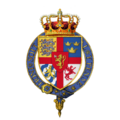Herb Danii
 Królewski herb Danii | |
| Warianty | |
 Średni herb Danii | |
 Mały herb Danii | |
| Informacje |
Herb narodowy Danii sięga czasów króla Waldemara I Wielkiego. W polu złotym, trzy lwy błękitne kroczące w słup, koronowane i uzbrojone czerwono, pomiędzy dziewięcioma czerwonymi sercami.
Tak jak i herby innych krajów, w trakcie historii przeszło szereg zmian. Królewska korona, której zwieńczenie na początku było otwarte, od 1624 roku została przekształcona w koronę zamkniętą. Nad nią góruje krzyż. Korona symbolizuje zarówno władzę monarszą jak i państwową.
Herb oraz jego fragmenty znajdują się dziś na rewersie monet duńskich splecione z monogramem aktualnego władcy (obecnie królowej Małgorzaty II).
Herb Danii jest zbliżony wyglądem do herbu Estonii, co wiąże się z duńskim panowaniem w Estonii.
Wersje historyczne herbu
Herb Waldemara Atterdaga
Herb Eryka Pomorskiego
Herb królestwa Danii i Norwegii w latach 1559-1699
Herb królestwa Danii i Norwegii w latach 1699-1819
Herb Danii w latach 1819-1903
Herb Danii w latach 1948-1972
Zobacz też
Media użyte na tej stronie
Autor: Sodacan, Licencja: CC BY-SA 3.0
Royal Arms of Norway & Denmark (1559-1699)
Autor: Ta ^specifik^ z W3C grafika wektorowa została stworzona za pomocą Inkscape., Licencja: CC BY-SA 3.0
Arms of the Danish Royal House and HM Queen Margrethe II of Denmark.
Autor: Samhanin, Licencja: CC BY 3.0
Early seal of Danish King Valdemar Atterdag. This seal is known from documents dating 1340-1345. The title seems to incidate that he used the seal before becoming king, i.e. as a young squire.
Autor: Rs-nourse, Licencja: CC BY-SA 3.0
Coat of Arms of Eric VII, King of Denmark, Sweden, and Norway<br\ >
Reference the Seal of Danish, Norwegian and Swedish monarch, King Eric of Pomerania. His seal is viewable on documents dating 1398-1435. Image available in print in THISET, Anders (1850-1917), Danske kongelige Sigiller, Copenhagen: C.A. Reitzel, 1917.
Autor: Sodacan, Licencja: CC BY-SA 3.0
Coat of Arms of the Danish Royal House from 1903-1948, and HM Kings Christian IX, Frederick VIII, Christian X, Frederick IX of Denmark.
Autor: Sodacan, Licencja: CC BY-SA 3.0
Frederik IX of Denmark's royal arms after 1948 (also designated as the "greater coat of arms" until 1959, when its use was reserved for the monarch rather than the Danish state). Unlike the arms of his daughter, Queen Margrethe II, this arms contains insignia corresponding to the medieval titles of "King of the Wends" [lindworm] and "King of Goths" [lion and hearts] and the ducal titles relating to Holstein [nettle leaf], Stormarn [swan], Dithmarsch [knight], Lauenburg [horse's head], and Delmenhorst [cross]. The use of the preceding symbols ended in 1972 when the current monarch ascended the throne. The arms of the cross between the main quarters of the shield are curved indicating a relation to the Order of the Dannebrog. In 1972, the arms of this cross were straightened out to imitate the Danish flag rather than the royal order. Except for various changes in the third quarter of the shield, all versions of the Danish "greater coat of arms" from 1819 to 1972 have otherwise been identical. 2. What is the national coat of arms?
Autor: Sodacan, Licencja: CC BY-SA 3.0
Coat of Arms of the Danish Royal House from 1819-1903, and HM Kings Frederick VI, Christian VIII, Frederick VII and Christian IX of Denmark.
Autor: Sodacan, Licencja: CC BY-SA 3.0
Coat of Arms of the Danish Royal House and HM Queen Margrethe II of Denmark.
Autor: Ta ^specifik^ z W3C grafika wektorowa została stworzona za pomocą Inkscape., Licencja: CC BY-SA 3.0
Royal Arms of Denmark & Norway, used from 1699 to 1819.


















